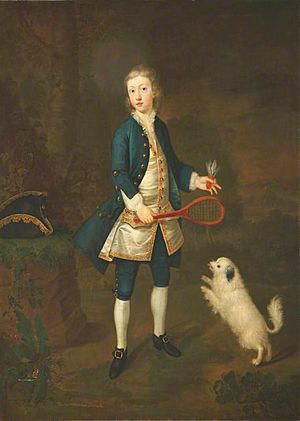Wilbraham Tollemache, 6th Earl of Dysart facts for kids
Quick facts for kids
Wilbraham Tollemache
|
|
|---|---|
 |
|
| Born | 21 October 1739 |
| Died | 9 March 1821 (aged 81) Ham House |
| Tenure | 1799–1821 |
| Other titles | Baronet of Helmingham Hall |
| Spouse(s) | Anna Maria Lewis |
| Occupation | MP for Northampton & Liskeard High Sheriff of Cheshire & High Steward of Ipswich |
|
|
|
Wilbraham Tollemache, the 6th Earl of Dysart, was an important British politician. He was born on October 21, 1739, and passed away on March 9, 1821. He was also a Fellow of the Royal Society (FRS), which means he was recognized for his scientific achievements.
Contents
Wilbraham Tollemache: Early Life and Career
Wilbraham Tollemache was the younger son of Lionel Tollemache, the 4th Earl of Dysart. He started his career serving in the Royal Navy, which is the UK's navy. Later, he joined the British Army. He retired from the army in 1775 as a major.
He then entered politics. In 1771, he became a Member of Parliament (MP) for Northampton. An MP is someone elected to represent people in the House of Commons, which is part of the UK's government.
On February 4, 1773, Wilbraham married Anna Maria Lewis. They did not have any children. He continued to serve as an MP for Northampton until 1780. After that, he represented Liskeard in Parliament until 1784.
In 1785, he held the position of High Sheriff of Cheshire. A High Sheriff was a very important local official. Later, he became the High Steward of Ipswich, a role also held by his older brother.
Becoming the Earl of Dysart
Wilbraham Tollemache became the Earl of Dysart when he was sixty years old in 1799. He inherited this title and all the family lands from his older brother, Lionel, who had no children.
One of the first things he did as Earl was to buy the manor (a large estate) of Canbury. This brought the land back into his family's ownership.
Improving Ham House and Loving Art
Wilbraham Tollemache made many improvements to Ham House, a historic family home. He created the "Yellow Satin Bedroom." He also changed the house by removing part of a wall to open up the view towards the river.
He moved statues of Roman Emperors to special spots in the house walls. He also added ha-has, which are hidden ditches that act as fences without blocking the view. He also added special statues made of Coade stone.
Wilbraham was a big fan of art and collected many pieces. He was one of the first people to support the famous painter John Constable. He also supported other well-known artists like Joshua Reynolds and Thomas Gainsborough.
A historian named Evelyn Pritchard described him as a kind and generous person. She said he was "cultivated, humane, generous, with polished manners, treating his dependents and servants extremely well." This means he was educated, caring, giving, and polite, and he treated the people who worked for him very well.
Family and Legacy
Wilbraham Tollemache died without having any children. Since all five sons of his father (the 4th Earl) had passed away and there were no grandsons, the Tollemache baronetcy (another type of noble title) ended.
The Earldom of Dysart then passed to his sister, Lady Louisa Manners. The family's lands were divided between Louisa and her younger sister, Lady Jane Halliday. Jane received lands in Helmingham, Suffolk, Cheshire, and Northants. Louisa inherited Ham House and the surrounding areas. Both sisters' families then took the name Tollemache.


